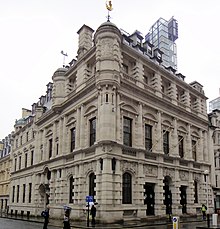Fenchurch Street
Fenchurch Street , originally also Fennieabout, is a street in the City of London . The street is part of an east-west connection through the city. It connects to Aldgate on the outskirts of the city to the east , and Lombard Street to the west .
Archaeological finds indicate that the location of Fenchurch Street was already in pre-Roman times a traffic route. In the 21st century, Fenchurch Street, like the rest of Eastern City, is characterized by offices and administrative buildings. The large complexes of Plantation Place and 20 Fenchurch Street are particularly striking . Fenchurch Street station is named after the street, but not directly on it .
history
The meaning of the name can no longer be understood with certainty today. Either the street, which used to be mostly called Fennieabout, is named after the fern ( Fen ) that grew at this point on the banks of the Langbourn River , or after the grain market (from Latin feanum for grain), which was in the street took place.
Archaeological finds on the site of today's roads date from Celtic times. From the time of Roman London three consecutive street surfaces were found, as well as the remains of various Roman warehouses and workshops. The houses and shops on Fenchurch Street were the first to see visitors to London as they entered the city through Aldgate . As the gate was one of the busiest, the shops and pubs on Fenchurch Street had a corresponding number of visitors.
Elizabeth I is said to have had her first meal on Fenchurch Street, at King's Head , in May 1554 , after Mary had released her from the Tower of London . It is said to have been pork with peas. The Miter , a favorite place of Samuel Pepys - and extensively praised in his diaries - no longer exists . It burned down in the Great Fire of London .
In Pepy's time, about half of the property on Fenchurch Street belonged to the Worshipful Company of Clothworkers , which also owned several other properties in London, making it one of the richest of the Livery Companies at the time.
buildings
The buildings on Fenchurch Street that no longer exist today include several churches including St Gabriel Fenchurch , St Benet Gracechurch , St Dionis Backchurch and St Katharine Coleman . St Gabriel Fenchurch, which burned down in the great fire and was not rebuilt, may have been the namesake for the whole street. The Worshipful Company of Ironmongers had its Livery Hall at 117 Fenchurch Street from 1587 to 1920.
- 20 Fenchurch Street , still under construction, one of the tallest buildings in the City. Replaces a high-rise building from the second half of the 20th century.
- Plantation Place , built in 2004 and successor to Plantation House , fills almost the entire block between Fenchurch Street, Great Tower Street , MIncing Lane and Rood Lane.
- Fountain House , 30 Fenchurch Street, was the first 14-story high-rise to be built in the City of London in 1957. The design is based on the New York Lever House .
- East India Arms , 67 Fenchurch Street, early 19th century pub and one of the oldest surviving buildings on Fenchurch Street.
- The Lloyd's Register , 71 Fenchurch Street is a mix of neo-Baroque from 1900 and a modern extension of the 21st century.
- The Elephant, 119 Fenchurch Street, made of solid stone, is one of the few buildings that survived the Great Fire of London . Nevertheless, the house was demolished in 1826 and rebuilt in a similar construction.
- Fen Court , a small park made up of the remains of the church yards of St Gabriel and St Mary. There are three burial sites from the 18th century.
Remarks
- ↑ a b c d e Fenchurch Street in: Ben Weinreb, Christopher Hibbert: The London Encyclopedia, Julia Keay, John Keay, 3rd, Macmillan, ISBN 978-1-4050-4924-5 , p. 289
- ^ A b c Simon Bradley, Nikolaus Pevsner: London 1, The city of London, 1997, London: Penguin. ISBN 978-0-300-09624-8 , pp. 486-490
- ↑ a b Map of Early Modern London: Fenchurch Street
literature
- Simon Bradley, Nikolaus Pevsner: London 1, The city of London, 1997, London: Penguin. ISBN 978-0-300-09624-8 , pp. 486-490
Web links
- Map of Early Modern London: Fenchurch Street
Coordinates: 51 ° 30 ′ 42.5 " N , 0 ° 4 ′ 52.3" W.


